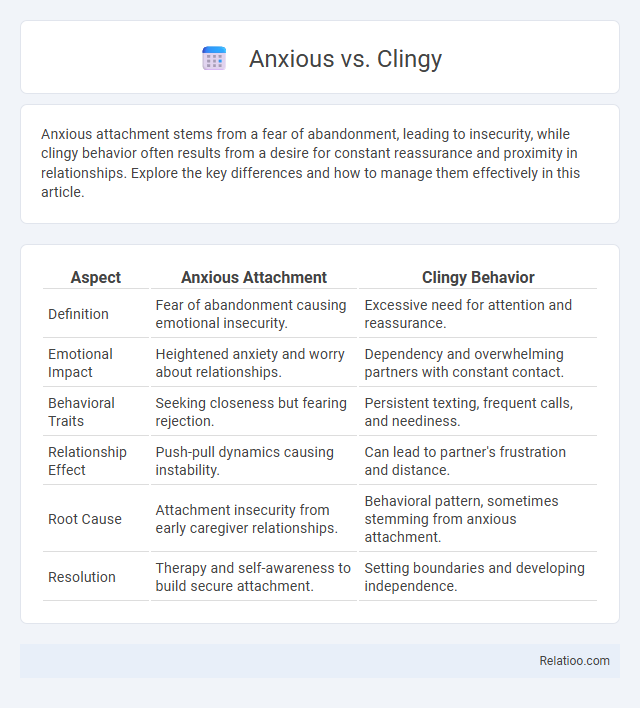Anxious attachment stems from a fear of abandonment, leading to insecurity, while clingy behavior often results from a desire for constant reassurance and proximity in relationships. Explore the key differences and how to manage them effectively in this article.
Table of Comparison
| Aspect | Anxious Attachment | Clingy Behavior |
|---|---|---|
| Definition | Fear of abandonment causing emotional insecurity. | Excessive need for attention and reassurance. |
| Emotional Impact | Heightened anxiety and worry about relationships. | Dependency and overwhelming partners with constant contact. |
| Behavioral Traits | Seeking closeness but fearing rejection. | Persistent texting, frequent calls, and neediness. |
| Relationship Effect | Push-pull dynamics causing instability. | Can lead to partner's frustration and distance. |
| Root Cause | Attachment insecurity from early caregiver relationships. | Behavioral pattern, sometimes stemming from anxious attachment. |
| Resolution | Therapy and self-awareness to build secure attachment. | Setting boundaries and developing independence. |
Understanding Anxious vs Clingy: Key Differences
Anxious behavior stems from internal feelings of insecurity and fear of abandonment, often leading to clinginess as a coping mechanism. Clingy behavior is characterized by an excessive need for attention and reassurance, which may result from or exacerbate anxiety. Understanding these key differences helps you better address the root causes of emotional dependency and build healthier relationships.
What Does It Mean to Be Anxious in Relationships?
Being anxious in relationships means experiencing excessive worry about a partner's feelings, loyalty, and potential abandonment, often leading to heightened sensitivity and emotional distress. This anxiety triggers clinginess, characterized by constant need for reassurance and fear of separation. Understanding these behaviors helps distinguish between healthy attachment and problematic clinginess, highlighting the importance of emotional regulation and trust-building.
Defining Clinginess: Signs and Behaviors
Clinginess is characterized by an excessive need for attention, reassurance, and closeness, often manifesting through frequent calls, constant messaging, or difficulty spending time apart. Signs include insecurity-driven behaviors such as jealousy, possessiveness, and a fear of abandonment that interfere with your ability to maintain healthy independence within relationships. Understanding these behaviors helps differentiate clinginess from general anxiety or normal affection, allowing for better emotional boundaries and relationship balance.
Causes of Anxiety and Clinginess in Individuals
Anxiety and clinginess often stem from underlying emotional needs and insecurities, such as fear of abandonment or low self-esteem. Your brain's heightened stress response triggers anxious thoughts, while clinginess emerges as a coping mechanism to seek reassurance and safety in relationships. Understanding these causes can help address the root issues and improve emotional well-being.
Emotional Triggers: How Anxiety and Clinginess Develop
Anxiety and clinginess often stem from emotional triggers linked to fear of abandonment and insecurity in relationships. You may develop clinginess as a coping mechanism when anxiety heightens sensitivity to perceived rejection or uncertainty about your partner's affection. Understanding these emotional roots is crucial for managing unhealthy attachment behaviors and fostering emotional resilience.
Impact on Relationships: Anxious vs Clingy Partners
Anxious partners often experience fear of abandonment, leading to heightened sensitivity and frequent reassurance-seeking, which can create emotional strain and miscommunication in relationships. Clingy partners tend to exhibit excessive dependence and possessiveness, resulting in restricted personal space and increased partner frustration. The impact of anxiety centers on emotional insecurity, while clinginess directly affects relational boundaries, both requiring understanding and balanced communication to maintain healthy partnerships.
Identifying Your Attachment Style
Identifying your attachment style involves recognizing patterns of anxious, clingy, or clinginess behaviors in relationships, such as constant worry about abandonment or excessive need for reassurance. Anxious attachment often triggers heightened emotional responses, while clinginess can manifest as persistent physical or emotional dependence. Understanding these differences helps you address your attachment needs and fosters healthier, more secure connections.
Healthy Boundaries: Managing Anxiety and Clinginess
Understanding the differences between anxious, clingy, and clinginess behaviors helps you set healthy boundaries that foster emotional well-being. Managing anxiety involves recognizing triggers and practicing self-regulation, while addressing clinginess requires clear communication and respect for personal space. Establishing these boundaries nurtures trust and independence, promoting healthier and more balanced relationships.
Coping Strategies for Anxious and Clingy Tendencies
Coping strategies for anxious and clingy tendencies involve recognizing emotional triggers and developing healthy boundaries to maintain personal space. You can practice mindfulness techniques, such as deep breathing and journaling, to manage anxiety while fostering self-confidence to reduce clinginess in relationships. Seeking professional support or joining support groups also enhances emotional regulation and promotes independence.
Seeking Help: When to Consult a Mental Health Professional
Recognizing when anxious behaviors escalate into clinginess that disrupts daily functioning is crucial for determining the need to seek professional help. Persistent anxiety coupled with excessive clinginess may indicate underlying mental health conditions requiring evaluation by a licensed therapist or psychiatrist. Early intervention with cognitive-behavioral therapy or counseling can effectively address these symptoms and improve emotional regulation and interpersonal relationships.

Infographic: Anxious vs Clingy
 relatioo.com
relatioo.com